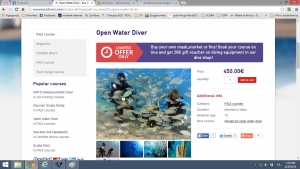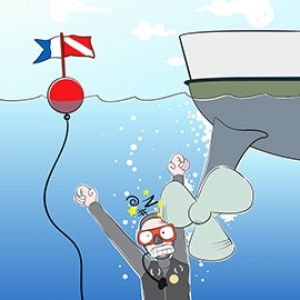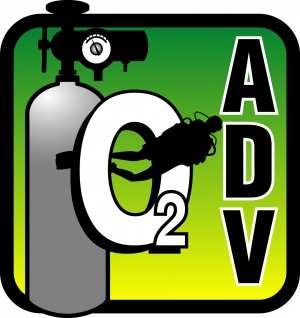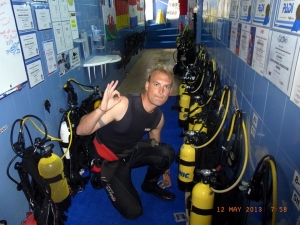Kostas Marmarinos
Early booking offer for 2015
Early booking offer! Book your course on line for summer 2015 until 10/02/2015 and get up to 30% discount!
View all available offers here
Upgrade Padi Scuba diver to Padi Open water diver / Private
SSL secure payment enabled
Your payments and personal data through kosdivers.com are even more secure. We are now SSL enabled with 128 bit encryption! Kosdivers.com is now more secure and stable than ever!
High season
For your better service please book on line your dives or courses early enough. Thank you all !
Theory Into Practice-Emergency Ascents: Managing the Risks

AlertDiver.eu, 2014; 55
An emergency ascent is the response of last resort to an adverse event or perceived threat during a dive. Divers are trained in standard emergency ascent procedures that, when performed successfully, mitigate the dangers. However, few people practice these skills, and when called to perform them in a crisis, a diver may be at risk for serious injury or even death.
The Stats
In a recent analysis of 964 diving fatalities, we found that emergency ascents were involved in 30 percent of cases — 288 to be exact. In 189 of these emergency ascents, a rapid ascent (faster than 60 fpm) was witnessed or recorded. In 10 percent of emergency ascents, divers attempted a free ascent without using a breathing gas supply. Buddy breathing was involved in 8 percent of fatal emergency ascents. In the remaining cases, the mode of emergency ascent was not specified.
The most frequent trigger of an emergency ascent is running out of breathing gas during the dive, an entirely preventable cause. For more on this topic, see Dive Safety: It' s No Accident (AlertDiver.eu, 2013; 52)
The most common cause of death in fatal emergency ascents is arterial gas embolism (AGE), accounting for 54 percent of cases, followed by drowning at 18 percent, acute cardiac events at 7 percent and decompression sickness at 5 percent. AGE is a stroke-like condition with sudden onset of weakness and unconsciousness that usually occurs within minutes of surfacing. It often renders a diver unconscious before he gets out of the water or soon after.
As divers, we all learn never to hold our breath underwater. Unfortunately, in an emergency situation, divers often forget this information and why it is important. As a diver ascends and the surrounding pressure drops, the air in his lungs expands. If the diver is breathing normally, this isn't a problem as the expanding gas escapes with every exhaled breath. The danger comes when the ascent is too rapid for this expanding gas to escape or when a diver holds his breath on ascent. The expanding gas has to go somewhere, and it can literally tear a hole in the diver's lung, leaking into the body. Lung overexpansion injuries include mediastinal emphysema (air between the lungs), subcutaneous emphysema (air underneath the skin) and pneumothorax (collapsed lung). But the biggest problem occurs when escaping gas is introduced into arterial circulation. At that point, there is nothing to stop it from being delivered directly to the brain, forming an embolus and blocking blood flow.
In the crisis of an emergency ascent, divers may forget their training or be afraid to exhale for fear of running out of breath before reaching the surface. When ascending from recreational diving depths, the expanding air in a diver's lungs is usually more than enough to sustain him. It's a rare instance when a diver drowns before reaching the surface.
Remember Your TrainingSo how do you deal with emergency ascents and the risk of injury? Like any diving emergency, the best way to deal with it is to avoid it in the first place. Keep your training current and in practice. Plan each dive carefully, and surface with a reserve supply of air. Follow your plan. And, of course, remember to monitor your air closely.
Let's say you do everything right and you still find yourself in a situation that requires an emergency ascent. What's the best way to proceed?
First, don't panic. You received training on how to do emergency ascents in your original certification course. Remember the preferred order of options:
- Make a normal controlled ascent, with your regulator in your mouth.
- Find your buddy and obtain his secondary air source (or his primary if he will be taking the secondary, depending on the configuration of his gear). The goal in this scenario is for both divers to have a continuous air source, enabling you both to make a slow, controlled ascent to the surface.
- If you cannot reach your buddy or another diver, or if your buddy is also out of air, complete a controlled emergency ascent on your own. But again, don't panic. Remember, you likely have enough air in your lungs to sustain you to the surface. Follow the procedures you learned in training: Keep your regulator in your mouth at all times; sometimes air expands and gives you one more quick breath. Exhale slowly and continuously all the way to the surface, and keep your ascent slow.
Like all other dive skills, emergency ascents should be practiced regularly. Head for the pool with a buddy to shake the cobwebs off your alternate air source breathing, and practice your emergency ascents by swimming horizontally in the pool.
Emergency ascents are a response to a life-threatening situation underwater. Despite the urgency in the circumstances surrounding them, with proper training, practice and preparation, they can and should be the safe solution they are intended to be.
Book on line offers
Propeller Injury Prevention Campaign
The following are some basic Safety Rules that should be followed in order to prevent propeller accidents.
FOR BOATERS
Preventing Propeller Accidents While on the Boat
- Stay at least 100 metres away from diver-down / alpha flags (Discover what a diver-down / alpha flag is), unless conducting SCUBA, snorkel or free diving activities.
Bear in mind that divers often have difficulty estimating distance underwater and could drift away from the flag. - Don’t let anyone onto the swim platform while the engine is in gear. Swim platforms tend to be slippery and divers could fall into the propeller.
- If you are leading a group of divers, make sure that divers entering the water do not come close to the propeller: they are sharp and dangerous, even when they’re not moving.
- Allow easy and safe re-boarding.
- Before starting the engine, make sure no diver is in the vicinity or under the boat.
FOR DIVERS
Preventing Propeller Accidents While Diving
- Always place the diver-down / alpha flag before diving. The flag can be attached to a float or mounted on a vessel and clearly visible from all directions.
- Always surface within 50 mt. of your dive flag, or close to the reef, if there's one.
- Use a surface marker buoy if an emergency surfacing far from the diver-down flag is needed.
- Watch your buoyancy and avoid uncontrolled ascents.
- While ascending, look around and pay utmost attention.
DAN
Dehydration & diving
What is dehydration and how does it influence diving safety?
Dehydration occurs when the body loses more fluid than is taken in and this can lead to medical problems that should be avoided.
Generally, these problems (especially in the case of chronic or severe dehydration) can result in headaches, decreased performance, irritability, confusion, fatigue, muscle cramps, reduction of thermoregulation, decreased level of consciousness, the production of kidney stones (long term) and can even lead to shock which is a life threatening condition. It is clear that these problems will negatively influence the medical condition of both divers and non divers and dehydration should therefore be avoided at all times.
But there is another concern: dehydration is a contributing risk factor for Decompression Sickness (DCS). To put it simply, dehydration will reduce the volume of blood plasma and perfusion of tissues (so it thickens the blood and reduces blood flow). The blood is responsible for the transportation of nutrients and for the exchange of gases. If the reduction in blood plasma becomes too great, it could lead to the decreased efficiency of gaseous exchange, thus also affecting the off-gassing of Nitrogen and increasing the risk of developing DCS.
How big is the risk on DCS?
In principle, diving increases the risk of becoming dehydrated. We have seen during some of our DSL projects that many divers are not well hydrated before the dive (and even less after the dive). In normal conditions however proper hydration should not become the main concern of divers, neither should it be ignored.
However, when going on a diving holiday the risk factor rises due to increased frequency of diving and (usually) increased climate. Therefore, appropriate hydration should be a key concern.
Why does the risk factor changes during my diving holiday?
Obviously the risk does not increase just because you are on a holiday, but there are behavioural and environmental factors that contribute to the diver becoming dehydrated much faster and without realising it.
In reality dehydration begins to develop when you enter the airplane that takes you to your preferred dive destination. The air in the cabin is much dryer than the air on earth and our lungs have to work harder to humidify the air, meaning your body is constantly losing fluids whilst on board.
It is recommended to drink 240ml of water each hour of the flight. So, if you would be travelling from the UK to Egypt, you would need to drink 1.2litres of water to maintain a good balance of fluid, while you would need approximately 750ml when flying from Italy to Egypt. These are volumes not many will drink during a flight.
Many travellers also like to drink coffee, coke or a beer during their flight, but these liquids just don't have the same hydrating effect as water. Alcohol and drinks containing caffeine are diuretics, consuming these will result in dehydration as they absorb water from the cells in your body and increase urine production. Consequently, the diver arrives at their destination with mild dehydration.
But this is only the beginning of the holiday. What do divers want to do during their holiday?
Enjoy the sun, enjoy the sea, dive as much as possible and why not have some fun and drinks in the evening.
Let's take a look at why this dehydrates you faster than normal?
Enjoy the sun
The most attractive dive destinations for the regular diver are those "warm water" locations where there are nice, big coral reefs and nicely coloured fish.
In these destinations there is a warm, sunny and sometimes humid climate.
It is clear that in these conditions you sweat and if you sweat you lose fluid, which if not replaced makes you dehydrated.
If you then also get sunburnt you will lose fluids even faster. When you have sunburn, your skin gets red and hot (and sometimes becomes painful) and our body reacts to this by sending fluid to the skin. The sun and wind will evaporate this moisture and even more fluid gets lost in this way.
Actually with these increased outdoor temperatures you also enjoy the wind and since most dives during holidays will be boat dives, you like to feel the wind on your skin which gives you that refreshing feeling. But in reality the wind (wind itself or the wind created by the velocity of the boat) evaporates sweat and moisture, increasing dehydration again.
Sea water - Salt
When coming out of the sea, the (salt) water will dry and leave salt crystals behind on your skin. These can often visually be seen, and have the ability to absorb and hold water molecules. This means it will take the moisture out of your skin, which then will evaporate due to the sun and wind, increasing dehydration further.
Diving
There are 3 things particular to diving itself that increase dehydration: Sweating, Immersion Diuresis (increased urine production) and breathing compressed air.
While the dive suit keeps you warm during the dive, it also does not allow you to cool down. So if you already are in a warm climate and are sweating when only wearing a t-shirt, imagine how much you will sweat under the dive suit.
During the dive, the increased ambient pressure and cooler water temperature will cause the blood vessels in the extremities to narrow and blood will be shunted from the extremities to the core of our body (heart, lungs and large internal blood vessels) in an effort to keep you warm. This increased blood volume in our core is seen by our body as a fluid overload. As a reaction the kidneys will produce more urine (which means losing water and salt again). This is also why divers feel the need to urinate during or immediately after the dive and this is referred to as Immersion Diuresis. Although one might think that when urinating a lot you are well hydrated, it actually means you are losing excessive fluids.
Another cause for loss of fluids while diving is the air you breathe. Just as in the airplane the air in the scuba cylinders is dry and you already know you lose more fluid to humidify this dry air. If you then also take into account that due to the colder water temperature, your lungs need to work even more to warm up the air, then you are increasing this moisture loss even more.
Alcohol
You are on holiday and it is not uncommon to have some fun and a few alcoholic drinks when enjoying your free time.
While dinking and diving is never recommended, alcohol also makes you dehydrate faster.
As you know already, alcohol (as well as coffee and other drinks containing caffeine) has a diuretic effect, increasing the urine output. This will make you urinate more frequently making you dehydrate.
Sickness
Vomiting, because you have been drinking too much or because you suffer from seasickness or for any other reason will heighten the rate of dehydration because you lose large amounts of fluid and electrolytes in a short period of time.
The same negative effect can be seen when you have traveller's diarrhoea, which is an intestinal infection that occurs as a result of unsanitary food handling.
Medication
Some medication, especially blood pressure medication has a diuretic effect and as you know this diuretic effect will lead to dehydration.
If you now consider that on a diving holiday, you like to dive daily and even twice a day, then you can understand the increased dehydration and DCS risk.
Obviously the risk does not increase just because you are on a holiday, but there are nine behavioural and environmental factors that contribute to the diver becoming dehydrated much faster and without realising it.
How do you know you are dehydrated?
Check the colour of urine. It should be transparent or light yellow. Darker coloured urine normally means that you are dehydrated (although the colour can also be influenced by certain medication). Little or no urine at all can indicate you are dehydrated but on the other hand a lot of urine does not automatically indicate you are well hydrated.
Symptoms of Mild-Moderate dehydration:
Thirst (drink before you are thirsty as thirst already means you are starting to get dehydrated)
Dizziness
Headache
Muscle cramps
Dry or sticky mouth
Tiredness
Dark coloured urine
Decreased urine output
Symptoms of Severe dehydration:
Extreme thirst and very dry mouth
Dry skin that sags slowly into position when pinched up
Rapid heartbeat, weak pulse
Rapid breathing
Sunken eyes and/or eyes that do not produce tears
Not passing urine for eight hours
Low blood pressure
Irritability and confusion
Seizures
Low level of consciousness
Extreme fatigue - Weakness
Most dehydration is mild and can easily be resolved by drinking more water. The use of Oral Rehydration Salts or Isotonic sport drinks in addition to water can also be considered as these will replace salts and electrolytes. However, where more severe symptoms are apparent, immediate medical care is required. It is clear that these problems will negatively influence the medical condition of both divers and non divers and dehydration should therefore be avoided at all times.
How to avoid dehydration?
It is much better to avoid dehydration instead of resolving it. Only by avoiding it, divers will reduce the risk of DCS.
After discussing dehydration and its effects on the body, we can conclude you should rinse yourselves down with fresh water after every dive, keep your dive suit off until right before the dive itself, avoid or moderate alcohol consumption or drinks with caffeine and protect yourselves from too much sun/sunburn.
But the easiest thing to do is to drink plenty of water.
However, you do not want to increase plasma volume too rapidly as this will only increase urine production again and not hydrate the body tissues. Therefore the advice is to drink a glass of water every 15-20 minutes instead of drinking a litre of water just before or after the dive. This will allow the tissues to be hydrated and consequently avoid the decreased gas exchange which can lead to bubble formation and DCS.
How much you actually need to drink depends on many factors, but drinking at least 2 litres extra (in addition to what you normally drink a day) will help you to keep hydrated.
You can also consider eating foods with a high water content, such as fruits and vegetables.
Some companies also sell drinking bags that can be used to drink under water, during the dive.
DAN
A heart under pressure
Diving is a very relaxing but also physically demanding hobby and descending several meters underneath the water surface means exposing the body to the pressure of the great quantity of water above the diver. That is why divers are being taught exercises to help their body adapt to the pressure changes and to equalise the pressure in the middle ears with the ambient pressure underwater. These maneuvers start a chain of internal pressure changes, allowing your body to accustomise itself to the new environment. However, what happens if there is a small defect in your body, let's say in the heart, causing a disruption in the chain of your body's automatic adjustments? What could be the implications of a defect in the heart, so small that in normal circumstances it would pass by unnoticed, but when put under pressure in diving, may cause serious risks? I am talking about a Patent Foramen Ovale (PFO), a small opening in the interatrial wall/septum seperating the two upper heart chambers and the health concerns it may create for a diver.
Scientific studies have shown that the Valsalva maneuver, performed by using your hand to block your nostrils and trying to exhale against a closed mouth and nose, sets a series of pressure changes in your body, in motion. The Valsalva maneuver starts by inhaling deeply, decreasing the pressure in the pleural cavity between the lungs (intrathoracic pressure). Sequently, you exhale against the resistance of a tapped nose and mouth for several seconds. The strain of this maneuver causes a high intrathoracic pressure. The pressure in the thorax hardly allows the blood to flow into the heart during a time-lapse of some seconds. Finally, the release of the Valsalva maneuver leads to a fall in pressure in the thorax and the blood, that during the strain could not flow into the heart, is now pooled out into the right upper chamber. This rebound blood loading increases pressure in the right part of the heart in expense of the left and pushes against the wall dividing the two heart chambers, causing a leftward bulging of the interarterial wall. In case of a Patent Foramen Ovale, a trans-esophageal echocardiography showed that this pressure reversal from the left to the right chamber creates a marked opening of a PFO.
A PFO is a rather common phenomenon and many divers may have an opening in the atrial septum (the internal wall) without even knowing it. As the Valsalva maneuver is used in diving and other maneuvers to equalise may have a similar pressuring effect on the heart, DAN Europe realized the need to study if these maneuvers can cause the same internal pressure changes and have the same effect on a diver's PFO. DAN did a research study on sixteen experienced divers, 4 females and 12 males, age ranging between 22 and 39 years. The divers were asked to do the following maneuvers used in diving: Control, Gentle Valsalva, Forced Valsalva, Calibrated Valsalva, Cough, Knee Bend with Valsalva, Free-breathing Knee Bend, and Final Isometric Contraction. The researchers analysed the level of intrathoracic pressure caused by the exercises and the measured values were compared to the original pressure value. In this way, it could be calculated whether a maneuver caused a rise or fall in intrathoracic pressure. The gathered data of each maneuver were compared to one another the results of the study showed that the Valsalva maneuver used in diving and other usual maneuvers for equalisation, only cause a slight increase in intrathoracic pressure. It is unlikely that these small changes in pressure cause a major blood shift through a PFO. On the contrary, if a Valsalva maneuver is forced, meaning using the abdominal muscles, DAN researchers found that it caused pressure changes in the right part of the heart large enough to allow significant blood flow through the PFO.
As said earlier, such an opening in the heart atrial septum is not uncommon and people do straining exercises, that causes blood to flow through the opening from the right upper chamber into the left, on the daily. So how come a PFO only becomes truly dangerous when diving? The reason is because it allows bubbles to travel! The blood containing these bubbles, which were created during the dive, passes through the right upper heart chamber and the blood will normally be sent to the lungs, where the bubbles are captured and the nitrogen is exhaled. Now, when the blood shifts through the PFO from the right upper chamber to the left upper chamber, the nitrogen bubbles can flow from the right part of the heart to the left part. The left upper chamber will send the blood with the bubbles back into circulation and these bubbles will thus remain longer in the blood flow, creating a risk for nitrogen gas emboli. DAN encountered cases where older and experienced divers, who never had any problems while diving, suffered unexplained Decompression Sickness after a dive, even though they had followed all diving safety rules. In many of these cases, on a trans-esophageal echocardiography, a large PFO could be detected.
DAN's research study showed that the “forced” Valsalva Maneuver caused a rise in intrathoracic pressure high enough for the rebound blood in the right chamber to cause an opening of a PFO. A diver should therefore always be taught to avoid forceful Valsalva maneuvers. The study pointed out that other, less straining equalisation maneuvers do not lead to significant changes in intrathoracic pressure and do not create a risk for divers with PFO. Special attention should be paid during dive training to rely on these maneuvers, that only use jaw and throat and not the abdominal muscles, for equalisation. As a direct result from this study, the advice from DAN researchers to divers with a PFO is to never perform maneuvers that increase the intrathoracic pressure while ascending. It is also recommended not to do abdominal straining exercises, such as climbing the ladder with the gear still on or inflating orally the BCD on surface, or strenuous leg or arm exercises after a dive. Silent bubbles can be present in the veins until two hours after a dive and these activities, using the abdominal muscles, will put pressure on the heart, opening the PFO and allowing the blood to flow in the wrong direction, carrying travelling bubbles around. So after a dive, just relax and don't put your heart under pressure!
diving season 2014
OK signal from Dennis for the start of 2014 diving season, after weeks of painting, cleaning, maintance and preparing a much better diving center. Matt, Jana, Caroline, Dennis and rookie Daniel are ready for service. The "Legend" Johnie Ocean will be here soon..



















